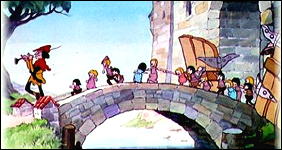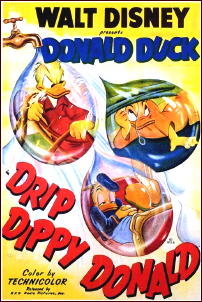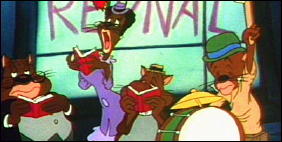Sat 22 Aug 2009
The CINEVENT 41 Animation Program: Reviewed by Walter Albert.
Posted by Steve under Comic Books, Cartoons, Comic Strips , Reviews[3] Comments
The Annual Animation Program. Cinevent 41, Columbus OH, May 2009.
It’s always a treat to see vintage cartoons (especially the color shorts in eye-popping color) on a decent sized screen. The well-chosen program featured some familiar (and readily available) shorts, along with some that had me shopping in the dealers’ room for decent copies on under-the-counter DVDs.

There are always some Disney shorts, but the Disney franchise has been so generous in recent years with their deluxe sets compiled from the company archives that the main pleasure of viewing them is in being reminded how spectacular Disney’s contribution to the art of animation has been.
“The Pied Piper” (1935) is from the Silly Symphony series and features a score by Leigh Harline whose contribution (he would later win an Oscar for his work on Pinocchio) greatly enhances the charm of this classic cartoon.
The Disney cartoons of the 1940s continued the tradition of superb animation artistry, but few people would claim they are as consistently funny as the Warner Brothers cartoons of that decade.
Still, Donald, who had replaced Mickey as the unquestionable star of the Disney stable of characters, could usually be counted on for some expert comic turns and did so again in “Drip Dippy Donald” (1948), where he’s trying to sleep and keeps getting waked up by a dripping faucet that eventually takes on nightmarish proportions.

There was the familiar Betty Boop black-and-white classic “Mother Goose Land,” a 1933 short that featured a still sexy Betty, a turn that would be ended by the Production Code and would, in effect, precipitate the decline in Betty’s popularity.
A later Popeye cartoon, “Service with a Guile” (1946), was entertaining, but the continuous flow of inspired animation that distinguished the ’30s Fleischer product was largely missing from this routine effort.
Two Walter Lantz cartoons, “Under the Spreading Blacksmith Shop” (1942) and “Swing Your Partner” (1943), served to remind me of how little I care for most of the Lantz-produced cartoons.
A controversial Bugs Bunny short, “All This and Rabbit Stew” (1941), initiated the screening of three politically incorrect shorts, now infrequently shown because of their use of black stereotypes. The Elmer Fudd role as Bugs’ hapless antagonist is here taken by a black hunter, based on the popular but offensive (to many people) comedian Stepin Fetchit.
The cartoon, not credited to Tex Avery but reputedly one of the last he directed before leaving Warner Brothers for MGM, If not one of his best efforts, still contained elements of the inventive slapstick that betrays the inimitable Avery touch.

The other two shorts from that category were probably two of the most creative of the morning’s program.
The racial stereotypes in Avery’s charming and very funny “Half Pint Pygmy” (1948) are much less blatant than those in the Bugs Bunny cartoon, but in Bob Clampett’s “Tin Pan Alley Cats” (1943), a graphically stunning short, they’re in full flower (as it were), as a musician, a recognizable caricature of Fats Waller, finds himself transported into a Surrealist landscape that is mostly lifted from “Porky in Wackyland,” a 1938 release also directed by Clampett.
The black and white original was redrawn and reshot in dazzling technicolor, with an array of fantastic creatures who seem to bear more than a passing resemblance to some of Boris Artzybasheff’s other-worldly inventions.
In any event, this was an exhilarating experience that propelled me into the dealers’ room where I found a copy in a set that contains all of the notorious racially and politically incorrect cartoons that you can find on YouTube on a good day.
August 22nd, 2009 at 11:02 pm
Clampett always claimed about “Tin Pan Alley Cats” that he was concerned about it so he previewed it for some black musicians who supposedly loved it. If you get a chance to see the work he did on a proposed John Carter of Mars animation it is great.
One of my favorite Donald Duck shorts (sorry, don’t remember the name) features Donald trying to read a mystery at home on a dark and stormy night with the events of the story intruding into reality. And of course there is always Daffy’s turn as “Duck Twacey.”
August 23rd, 2009 at 12:19 pm
Watching cartoons such as TIN PAN ALLEY CATS from today’s perspective can easily be troubling, but I think deleting the offensive scenes, or banning the cartoons altogether, is worse than letting them be seen.
Heavy-handed censorship such as this tries to say, in effect, that racism never existed.
And in terms of racist statements, some of the stereotypes of blacks presented in cartoons in the 1940s are as innocent as the exaggerated characteristics of the Irish or Jewish communities. But even though each of us has different lines that should not be crossed, in terms of depictions of blacks, it’s also obvious that lines were crossed.
You can easily judge for yourself. While they may disappear, at the moment all of the links in Walter’s review go to current YouTube offerings.
August 23rd, 2009 at 7:20 pm
I think now that there are other more positive images of minorities on screen some ‘political correctness’ will ease and we can look at this material and perhaps see it for what it is rather than automatically lable it as racist.
I know a superficial look at Stepin Fechit in the films he did with John Ford and Will Rogers seems at first just another derogatory stereotype, but as you watch and pay attention you start to see that Ford, Rogers, and Stepin Fetchit are often taking shots at expectations — there is that great scene in Judge Priest of Stepin Fechit marching in the Confederate parade with an American flag that you know the liberal Ford meant as a very rebellious moment.
And to be honest I always thought Stepin Fechit, Willie Best, Eddie Anderson, and Mantan Moreland had perfectly sensible reactions to some of the film situations they were put in. Sometimes I couldn’t figure out why the lunkheaded hero wasn’t out of the door ahead of them.